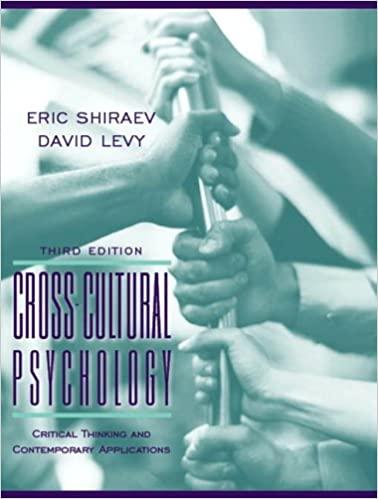Question
Note for reply posts: Each reply needs to find common ground (agreement) as well as uncommon ground (disagreement) with your peer. In other words, identify
Note for reply posts:Each reply needs to find common ground (agreement) as well as uncommon ground (disagreement) with your peer. In other words, identify 2-3 points with which you agree or disagree. Explain why you agree and/or disagree with each point. Doing so will expand your as well as your peer's understanding of the issue.In addition, each reply needs to ask your peer one or more questions that expand their understanding of the issue.
I find it relatively easy to get close to others and am comfortable depending on them and having them depend on me. I don't worry about being abandoned or about someone getting too close to me (Hazan & Shaver, 1987).
I believe there is a relationship between early attachment experiences and adult attachment styles. I can defiantly agree with the attachment style I chose because of the type of household I grew up in as a child. Someone who comes from a home with love, happiness, laughter, would grow up to be more open to love and able to learn, communicate and have a successful relationship. The way someone grows up would be somewhat the way they would treat other people in their life that they have developed a true meaningful relationship with. For example, someone who was brought up in a rough environment throughout their life might have trouble trusting people, which affects communication. Communication is one of the top keys to a successful relationship.
For my style it would be a secure style. It would be secure because of the way I was raised as a child and what I have seen as a child. My household was always an active house where friends and family would come over and hangout and have a lot of laughs and good time along with nothing but love. My parents showed me what true love was and as I got older, I was able to find someone I was comfortable with and wanted to spend the rest of my life with. My parents continue to show love not only to each other, but to my siblings and friends.
If I was a therapist and having a session about the topic of attachment styles, I would attempt to start breaking down the building blocks and try to listen about the childhood of my client. I would go back to their childhood and start there with questions. For example, asking if they came from a two-parent person home because sometimes that can take a toll on a child growing up. Then continue going through each stage of life and find out the root of the issue and see if we could try to change the way they think about the subject or see it differently, or even change the motivational outlook of a situation or relationship.
Step by Step Solution
There are 3 Steps involved in it
Step: 1

Get Instant Access to Expert-Tailored Solutions
See step-by-step solutions with expert insights and AI powered tools for academic success
Step: 2

Step: 3

Ace Your Homework with AI
Get the answers you need in no time with our AI-driven, step-by-step assistance
Get Started


